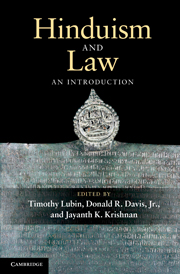Book contents
- Frontmatter
- Contents
- List of contributors
- Acknowledgements
- Chronology
- Abbreviations
- Map South Asia: political divisions c. 1860 and today
- Introduction
- Part I Hindu law
- Part II Law in ancient and medieval Hindu traditions
- Part III Law and modern Hinduism
- Chapter 12 Temples, deities, and the law
- Chapter 13 In the divine court of appeals
- Chapter 14 Contemporary caste discrimination and affirmative action
- Chapter 15 Law and Hindu nationalist movements
- Chapter 16 Legally and politically layered identities
- Glossary
- Bibliography
- Index
Chapter 16 - Legally and politically layered identities
a thumbnail survey of selected Hindu migration patterns from South Asia
Published online by Cambridge University Press: 05 June 2012
- Frontmatter
- Contents
- List of contributors
- Acknowledgements
- Chronology
- Abbreviations
- Map South Asia: political divisions c. 1860 and today
- Introduction
- Part I Hindu law
- Part II Law in ancient and medieval Hindu traditions
- Part III Law and modern Hinduism
- Chapter 12 Temples, deities, and the law
- Chapter 13 In the divine court of appeals
- Chapter 14 Contemporary caste discrimination and affirmative action
- Chapter 15 Law and Hindu nationalist movements
- Chapter 16 Legally and politically layered identities
- Glossary
- Bibliography
- Index
Summary
Introduction
This chapter will survey the several historic centers of the Hindu diaspora and the circumstances that led to these migrations, offering a brief discussion of the legal and political issues encountered by the Hindu communities in their adopted homelands, and the responses these communities have offered in order to solidify or improve their position within their respective societies. In addition, illustrative case studies will be interspersed that shed light on how the Hindu communities in their environments have asserted their legal and political status, which routinely has involved claiming not simply a Hindu identity, but multiple, or layered, identities instead.
Defining “diaspora” and mapping who went where
The use of the term “diaspora” has been a matter of debate among scholars (see, e.g., Brown 2006: 4; Chander 2001: 1,006; Rukmani 2001: xi; Vertovec 2000: 141–59). Here we will adopt Brown’s proposal to apply the word “diaspora” to:
groups of people with a common ethnicity; who have left their original homeland for prolonged periods of time and often permanently; who retain a particular sense of cultural identity and often close kinship links with other scattered members of their group, thus acknowledging their shared physical and cultural origins; and who maintain links with that homeland and a sense of its role in their present identity.
(Brown 2006: 4)The value of Brown’s definition is that it allows for considering a range of factors – from flight from persecution to voluntary migration – in modeling a South Asian Hindu diaspora.
- Type
- Chapter
- Information
- Hinduism and LawAn Introduction, pp. 252 - 265Publisher: Cambridge University PressPrint publication year: 2010



